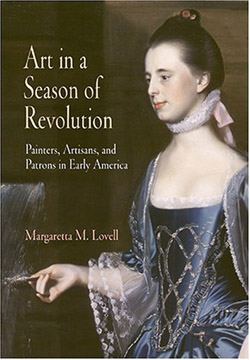“They Had Faces Then”


Anyone who has even a fleeting knowledge of American art history knows that portraits abound in the eighteenth century. The typical American-art survey begins with face after face from the past . . . and little else. Why did Americans commission only portraits from their artists? Other genres flourished in Great Britain, the model for much of American culture in this period. Why not here? Was it all vanity and conspicuous consumption—the same class ambitions that drive Americans to covet today’s Hummers and BMWs? According to art historian Margaretta Lovell, the answer is a surprising but firm “no.” In her new book, Art in a Season of Revolution, Lovell takes on some of the big questions of eighteenth-century painting and culture and reveals a somewhat different story than that often taught in art history courses.
Lovell approaches her study by selecting discreet groups of objects, largely paintings, and examining them from a variety of angles. In an effort to move beyond the connoisseurship model used by many earlier scholars, she has selected for her case studies not only canonical masterpieces but also intriguing “lesser” works. Quality aside, each work in turn reveals a great deal about eighteenth-century artistic practice. Lovell also takes the novel approach (for art history) of including a chapter on cabinetmakers among the several she devotes to painting. Although the book might have benefited from a few additional studies of craftsmen, this single example raises provocative questions about just how much we know about well-known artisans such as the Townsend-Goddard cabinetmakers.
Following a common practice among scholars of material culture, Lovell treats the objects of her study as primary documents. For instance, Lovell finds in family-group portraits new ideas about childhood and family “that had become visible by 1760, but would not reach the horizon of audibility in the written record for another two decades” (269). For example, fathers, who in the first half of the eighteenth century dominated family portraits, were by midcentury placed in positions that “encourage us to focus on his progeny and not on him” (156). Similarly, mothers in the later period often move into the center of the canvas, elevated by their custodial relationship to the child. Lovell makes her point through a compelling array of examples culled from Anglo-American portraits of the period.
Family ties are also central to her argument. While many other scholars have characterized these portraits as self-aggrandizing monuments to wealth and vanity, Lovell pokes two holes in this observation. First, according to probate records, portraits of family members were often hung not in parlors frequented by guests but in rarely visited private rooms. Second, she notes that unlike other luxury goods, such as furniture or silver, family portraits had almost no resale value. They were valued for their subject matter rather than their aesthetic qualities. Art buyers were thus unlikely to be drawn to portraits of another’s kin. Additionally, Lovell observes that portraits were not purchased merely by those who could afford them but instead tended to end up in the hands of those with inheritable estates. This, according to Lovell, reveals a core function of portraiture—the reinforcement of kinship ties and familial obligation among leading heirs.
Kinship ties also play an important role in artist-patron relations. Among artists and craftsman, Lovell notes how kinship and patronage were often closely aligned. For example, John Singleton Copley’s marriage to the wealthy Susanna Farnham Clarke afforded him access to a new network of wealthy patrons. In her thorough study of the Townsend-Goddard cabinetmakers, Lovell goes even further in connecting the dots between artisans and patrons, suggesting that women “performed the function of permanent adhesive” (241), cementing business partnerships between men in the same trade. She also examines the Townsend-Goddard patron base, noting that many of their local purchasers were either kin or coreligionists.
Lovell performs a similarly revealing piece of research as she unravels the connections between three of Copley’s female sitters, each shown wearing the same blue dress. Although we know that Copley sometimes recycled costumes in unrelated portraits, the case of the blue dress is one of those instances that puzzles. Unlike cases where Copley derived multiple compositions from a single print, his portraits of the women in the blue dress each show their sitter in distinctly different poses, revealing an entirely different view of the dress. After disproving a number of possible reasons for the duplication of the dress—for example, that it was owned by Copley himself—Lovell works to establish the connections between the three women, suggesting that the dress was owned by one and borrowed by the others. She affirms this unlikely scenario by connecting the three sitters through distant kinship ties and their links to real estate on Essex Street in Salem, Massachusetts. With such evidence neatly laid out, Lovell’s conclusions seem plausible.
This slim but dense volume also has much more to add about the nature of drawing, originality, classicism, and the crafting of a professional identity in eighteenth-century British America. With so much between its covers, Lovell’s book is a remarkably important addition to the study of American art history. Not to diminish its significance, but its geographic limitations should be acknowledged—Lovell’s study examines only a narrow sliver of New England visual culture, with an equally limited cast of characters. Hopefully, others will continue this line of scholarship in the mid-Atlantic as well as the South and perhaps even begin to incorporate more vernacular objects along with such high-art examples. Given the emergence of a number of younger scholars in this area, it seems certain that American art of the eighteenth century, long suffering from extended periods of neglect, is finally getting its due.
This article originally appeared in issue 6.1 (October, 2005).
Akela Reason holds a Ph.D. in art history from the University of Maryland. She is currently preparing a book on the Philadelphia painter Thomas Eakins.